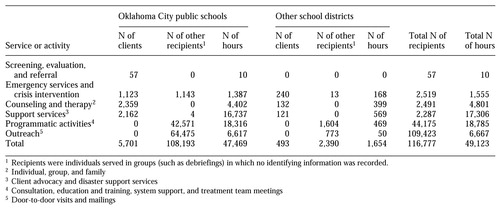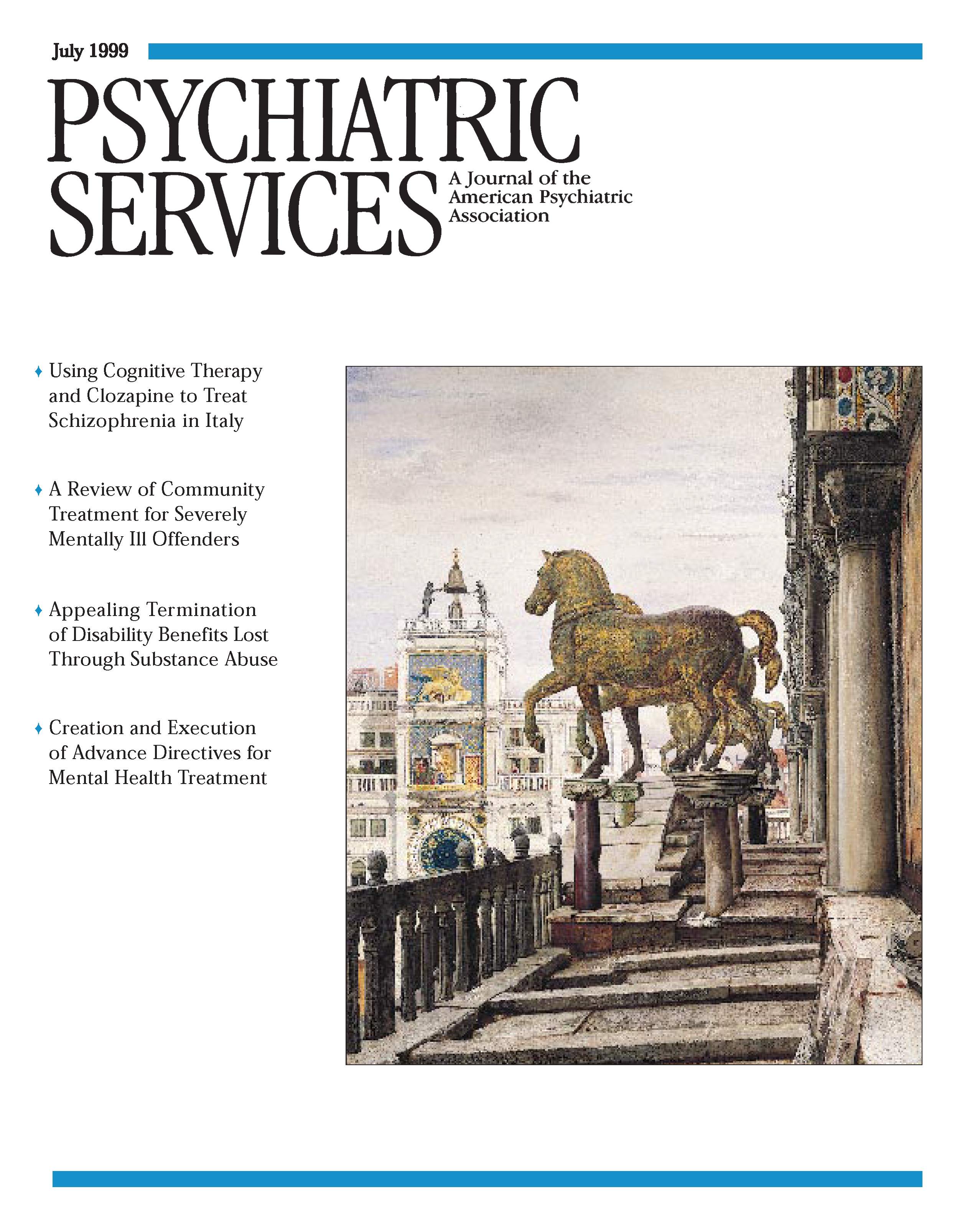Mental Health Services for Children in the First Two Years After the 1995 Oklahoma City Terrorist Bombing
Abstract
Nineteen infants and children were killed in the 1995 terrorist bombing in Oklahoma City, and many were injured. More than 200 children lost one or both parents. These casualties focused attention on children in the disaster response efforts. This paper describes the development and implementation of a school-based mental health program that provided accessible services to children affected by the bombing, with an emphasis on normalization. A clinical needs assessment of all children in the Oklahoma City public school system was carried out, and clinicians provided emergency and crisis services, counseling, and support groups.
On April 19, 1995, a terrorist bomb exploded in a federal building in downtown Oklahoma City, leaving 168 people dead and 853 others injured. Most horrifying for many was learning that the day care center in the building was part of the destruction. Nineteen infants and young children were killed, and more were injured. More than 200 children lost one or both parents. Children were a major focus in the disaster response efforts.
In a companion paper, we described the mental health response to the bombing and the lessons learned (1). In this paper we chronicle the development of services for children administered through the federally funded program, Project Heartland, established by the Oklahoma Department of Mental Health and Substance Abuse Services (ODMHSAS) on May 15, 1995, less than a month after the bombing.
As described in the companion paper, the goals of Project Heartland were to provide crisis counseling and training. Outreach and accessibility of services are key aspects of federally funded disaster programs. In this paper we identify issues related to services for children that are likely to be important in response to future disasters, and we make recommendations based on our experience.
Initial response
Service settings
Most services for children were located at school sites primarily in the Oklahoma City public schools, a contract partner of Project Heartland. A network of providers was also established in the community to provide services free of charge or at a much-reduced rate to children and their families who had serious and enduring problems.
At the time of the bombing, the Oklahoma City public schools had an enrollment of approximately 40,000 students, with about 5,800 staff. The bomb site was within the boundaries of the school district, and six schools were within five miles of the site. One school sustained structural damage, and one evacuated students and staff. Project Heartland also provided services to students and staff in surrounding school districts and private schools, with an additional enrollment of 66,000 students.
As the total figures in Table 1 show, close to 50,000 contact hours were provided to more than 5,000 students, parents, and school personnel through individual counseling, support groups, training, and other services. The largest number of hours of services was provided for programmatic activities, including consultation, education and training, system support, and treatment team meetings. Support services, including advocacy and support interventions, was the next largest service group in terms of hours. Outreach activities included parent meetings and educational publications. Individual, group, and family counseling were available. Groups were formed based on age, relationship to loss, school site, and other factors.
Chronology of response
On April 19, 1995, the day of the bombing, the American Red Cross established a crisis intervention and death-notification center in downtown Oklahoma City. On May 15 Project Heartland opened, with a central office near downtown. In May the United States Department of Education consulted with the Oklahoma City public schools to develop response strategies. A clinical needs assessment was completed for use in planning services and funding requests (see below).
During the summer of 1995, a school district steering committee was established to review and coordinate bomb-related activities. Teachers and staff were trained in topics such as the emotional impact of disasters, the effects of trauma and grief on classroom behavior, holiday and anniversary reactions, stress management, expression through art, the impact of the trial, and conflict mediation.
In November 1995 federal funding was received and school-based services were initiated. Funding and programming were extended through December 1996. In the spring of 1997 school-based services were discontinued.
Experiences and recommendations
Immediate programming
Mental health professionals with experience in working with children were available to assist immediately after the bombing. They served on death-notification teams, provided therapy, and helped with a telephone bank. A cadre of approximately 20 full-time-equivalent counselors and approximately ten interns completing their training in mental health disciplines worked in the schools.
Initially, when families visited the notification center, children were separated from their parents in a play area. However, once the importance of maintaining family unity was recognized, children and families were not separated, and all waited for services in a general family room (2).
School-based services
Before the school summer recess of 1995, a clinical needs assessment was completed for use in planning services and funding requests. A clinical survey of middle and high school students was completed to identify those in need of mental health services (3). Youths completed questionnaires addressing exposure, initial response, bombing-related television viewing, and current symptoms including posttraumatic stress symptoms. Later assessments included surveys of elementary school children and group interviews (4).
A school district steering committee was established to screen requests from various public and private groups for school-based activities such as clinical and educational programs; the committee also screened media inquiries and research proposals. Careful thought was given to the appropriateness of programs for the school setting and to balancing needs for supportive intervention and for normalization. Because of the intense focus on children in the response, the school district was inundated with requests—most well meaning but some inappropriate. For example, individuals and groups promoting various interventions, including several with religious overtones, were evaluated for their appropriateness to the school setting. Other proposals were approved, such as research addressing the effects of the bombing on unwed teenage mothers, programs focusing on the legal process and on constitutional law, and some media requests.
Concern arose among some administrators and teachers that continued attention to the bombing was unnecessary and that it prolonged recovery. The committee provided a forum where these issues could be addressed, although many decisions ultimately rested with individual principals and teachers. Thus the availability of bombing-related counseling and enrichment programs varied greatly across schools.
During the summer of 1995, counselors interested in providing school-based services were identified. Students and trainees from psychology, social work, and licensed professional counseling programs provided a contingent of eager, if somewhat inexperienced, counselors at a relatively low cost. The students and trainees were supervised by faculty at their academic institutions and by Project Heartland staff.
Federal funding did not arrive until November 1995. By then, hundreds of students had been identified as in need of mental health services and many had already received services. Services were in place by the winter holidays, and the school-based program was fully operational in early 1996. One advantage of the delay was that services were funded to continue through the close of the 1996-1997 academic year.
Federal funds for disaster relief can be used only for time-limited services and cannot be used for comprehensive evaluation or intensive treatment. These restrictions ignore a developing body of literature documenting that psychological responses to disasters are sometimes severe and enduring. Surprisingly few children were referred by the school-based counselors to other programs established to provide bombing-related services (2), which caused some speculation that the program's focus on normalization, the relative inexperience of the counseling staff, and the desire of school-based counselors to maintain a role in the effort discouraged the referral of children in need of more comprehensive and intensive services. Crisis intervention and support services must be reinforced with active and consistent efforts to identify and refer persons with serious and potentially enduring problems.
Avoidance is at the core of the posttraumatic response, and it sometimes involves avoidance of treatment. Studies indicate that parents (5,6,7) and teachers (8) may not appreciate a child's distress after exposure to a trauma. Lack of attention to psychopathology by teachers and administrators and the tendency of individuals and families to deny symptoms are mutually reinforcing. Therefore, it is essential that public education and outreach services after a disaster include efforts to offset the effects of avoidance and denial.
Symptoms associated with posttraumatic stress are likely to emerge in the classroom, where intrusive thoughts and emotional arousal may disrupt attention and where sadness, grief, and anger may interfere with the learning process and social adaptation. The response to disasters outlined and funded by the federal government includes training for those who work with children in natural settings such as teachers and school personnel.
Conflict is common among individuals and agencies attempting the delicate task of coordinating postdisaster services (9). In Oklahoma City, difficulties arose despite early and consistent attempts to coordinate efforts. Once individuals and agencies felt slighted, they tended to respond with bias, perpetuating strained interactions and relationships. These conflicts may partly explain why some complaints arose that children in need of more comprehensive and intensive services were not appropriately referred.
As the Oklahoma City community continued its process of recovery into the third year, the highly publicized criminal trials created new challenges for residents and mental health care providers. Most have been able to integrate the effects of this tragedy. However, the threat of a future involving violence and terror is a reality for our children and society.
Dr. Pfefferbaum is professor and chairman of the department of psychiatry and behavioral sciences at the College of Medicine at the University of Oklahoma Health Sciences Center, 920 S. L. Young Boulevard, Williams Pavilion, No. 3470, Oklahoma City, Oklahoma 73104 (e-mail, [email protected]). Dr. Call is in the private practice of forensic and clinical psychology in Oklahoma City. Dr. Sconzo is assistant superintendent for educational services for the Oklahoma City public schools.
 |
Table 1.
Services and activities provided in Oklahoma City public schools and other school districts in the first two years after the Oklahoma City terrorist bombing in April 1995
1. Call JA, Pfefferbaum B: Lessons from the first two years of Project Heartland, Oklahoma's mental health response to the 1995 bombing. Psychiatric Services 50:953-955, 1999Link, Google Scholar
2. Tassey JR, Carll EK, Jacobs GA, et al: Task Force on the Mental Health Response to the Oklahoma City Bombing: Final Report. Washington, DC, American Psychological Association, July 1997Google Scholar
3. Pfefferbaum B, Moore VL: Effects of disaster on school children. Presented at the annual meeting of the American Psychiatric Association, May 4-9, 1996, New York CityGoogle Scholar
4. Allen SF, Dlugokinski EL, Cohen LA, et al: Assessing the impact of a traumatic community event on children and assisting with their healing. Psychiatric Annals 29:93-98, 1999Crossref, Google Scholar
5. Applebaum DR, Burns GL: Unexpected childhood death: posttraumatic stress disorder in surviving siblings and parents. Journal of Clinical Child Psychology 20:114-120, 1991Crossref, Google Scholar
6. Handford HA, Mayes SD, Mattison RE, et al: Child and parent reaction to the Three Mile Island nuclear accident. Journal of the American Academy of Child and Adolescent Psychiatry 25:346-356, 1986Crossref, Google Scholar
7. Sack WH, McSharry S, Clarke GN, et al: The Khmer adolescent project: I. epidemiologic findings in two generations of Cambodian refugees. Journal of Nervous and Mental Disease 182:387-395, 1994Crossref, Medline, Google Scholar
8. Yule W, Williams RML: Post-traumatic stress reactions in children. Journal of Traumatic Stress 3:279-295, 1990Crossref, Google Scholar
9. Pynoos RS, Goenjian AK, Steinberg AM: A public mental health approach to the postdisaster treatment of children and adolescents. Child and Adolescent Psychiatric Clinics of North America 7:195-210, 1998Crossref, Medline, Google Scholar



